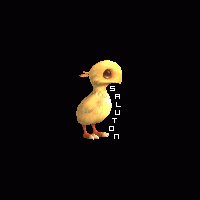Messages: 13
Language: English
CharlesReynolds (User's profile) December 10, 2012, 12:28:11 AM
I'm currently muddling my way through the maddening Boldoj kaj Demandoj, here. I've also downloaded the Kurso de Esperanto computer program and The Esperanto Teacher (Helen Fryer) in epub. Will changing back-n-forth between learning sources during my initial experiences cause me grief?
Thanks
erinja (User's profile) December 10, 2012, 3:35:53 AM
Maverynthia (User's profile) December 10, 2012, 3:46:29 AM
I want to use the Kurso de Esperanto program but the real life human they have for it sounds..creepy. (I'd kinda hoped they'd have a few people on it.)
CharlesReynolds (User's profile) December 10, 2012, 8:57:50 AM
erinja:If you find Bildoj kaj Demandoj to be maddening, I wouldn't do it.It's maddening because the mini-exams don't point out where my errors are and finding them for correction is, at best, tedious and reminds too much of fighting the debugger from my Computer Science 101 (Intro to Programming) course in college. I've donated to ESF to help pay for things like the new course material that was announced. Hopefully, the new material won't be so frustrating. I find that most of my errors are single-letter spelling mistakes which should be fairly easy to programatically locate, but the course isn't set up for that.
Maverynthia:I want to use the Kurso de Esperanto program but the real life human they have for it sounds..creepy. (I'd kinda hoped they'd have a few people on it.)I played around with it a little and I'm not so sure about the program. It's kind of neat, but there doesn't seem to be any means to actually record my responses or send them to the human reviewer.
I've been going through The Esperanto Teacher and using it to expand my vocabulary, mostly. I'm not sure that it isn't out of date, though. Is ci(a) still in use? I've not seen it outside this book. Also, it claims -n should be used to delineate the object differently from what I've seen elsewhere; suggesting that it be appended to everything _except_ the object.
I'll plow through Bildoj and get into Ana Pana. Based on how much easier it is to follow Mazi en Gondolando after three days of fairly intense study, I'm hoping to be able to find someone to Skype or text chat with sometime near month's end. If this seems an awkward or backward plan, I'm certainly open to suggestions for streamlining.
Ti* and Ki* are giving me fits, of course. Maverynthia, what's the Free Esperanto Course and how do I get it?
Dankon,
Ĉarlzo
J_Marc (User's profile) December 10, 2012, 9:13:49 AM
CharlesReynolds:I've been going through The Esperanto Teacher and using it to expand my vocabulary, mostly. I'm not sure that it isn't out of date, though. Is ci(a) still in use? I've not seen it outside this book. Also, it claims -n should be used to delineate the object differently from what I've seen elsewhere; suggesting that it be appended to everything _except_ the object.Ci was uncommon in Dr. Esperanto's day, I believe he even recmomended people not to use it. As a result of its strangeness, it has fans. I'm one, though I don't ever use it! It's probably in the Esperanto bible (where you'd see 'thou' in some English versions). Re the -n finaĵo, have you misread that bit? It's for direct objects, and sometimes is used instead of prepositions if doing so doesn't muddy up the clarity of the statement. I like The Esperanto Teacher, I think it has a very clear didactic style for such an old book.
erinja (User's profile) December 10, 2012, 5:03:39 PM
J_Marc:Ci was uncommon in Dr. Esperanto's day, I believe he even recmomended people not to use it. As a result of its strangeness, it has fans. I'm one, though I don't ever use it! It's probably in the Esperanto bible (where you'd see 'thou' in some English versions). Re the -n finaĵo, have you misread that bit? It's for direct objects, and sometimes is used instead of prepositions if doing so doesn't muddy up the clarity of the statement. I like The Esperanto Teacher, I think it has a very clear didactic style for such an old book.I believe that "ci" is not even in the Esperanto bible. It is not recommended to use it, ever, and Zamenhof suggested not to do it.
Bruso (User's profile) December 10, 2012, 5:23:16 PM
erinja:Hmmm. That's odd. So ... why did he write it into the language at all?
I believe that "ci" is not even in the Esperanto bible. It is not recommended to use it, ever, and Zamenhof suggested not to do it.
I've been bouncing around different sources myself. At a university library I found some old Auld books - "Esperanto: a New Approach" and "Paŝoj al Plena Posedo". I can keep them out for about 3 months. "New Approach" progresses very fast - I'd probably be lost if I was a complete beginner, or else I'd have to go much more slowly, but I'm learning a lot, and not just grammar and vocabulary, but style and idiom as well. I'm looking forward to "Paŝoj", which I'll probably try in parallel with a repeat of "New Approach", which I'm about 3/4 of the way through.
CharlesReynolds (User's profile) December 10, 2012, 7:04:26 PM
erinja:I believe that "ci" is not even in the Esperanto bible. It is not recommended to use it, ever, and Zamenhof suggested not to do it.Having grown up an anglophone, I always thought thee/thou/thine was just the formal case of you/you/yours. This discussion made me look it up. As defined at http://www.merriam-webster.com/dictionary/thou, I am not dissuaded from my original inferred definition.
That makes it completely unnecessary, and somewhat useless, in Esperanto since there exist more and more specific means of making clear the direct subject or object of any given statement or question.
J_Marc:Re the -n finaĵo, have you misread that bit? It's for direct objects, and sometimes is used instead of prepositions if doing so doesn't muddy up the clarity of the statement. I like The Esperanto Teacher, I think it has a very clear didactic style for such an old book.In terms of general usage re: to clearly designate the object (wishing I had more formal grammar training in school...), I think I have it figured. I'm still confused about its use with regard to numerical statements and prepositions. In fact, I'm still not sure what a preposition is. That's not true. I know what it is, I just need one of those "Aha!" moments to connect the notion to the word. Merely having it defined just isn't working for me.
I'm finding The Esperanto Teacher to be generally more useful than Bildoj. There are more examples of use through which to make those "Aha!" discovery-like connections to grammatical rules, which is really the best way get a firm grasp of it. Has anyone proposed a series of children's books to illustrate and explain things? Sort of a "Rigardas Diko. Rigardas Ĝajno." sort of thing where concepts can be arranged more for self-discovery through observation and inference than through rote definition and explanation.
Ĉarlzo
erinja (User's profile) December 11, 2012, 12:49:46 AM
Bruso:Hmmm. That's odd. So ... why did he write it into the language at all?I think he wanted to give the option, just in case it should ever come into use. And it is useful when talking about *other* languages that use it - you can use verbs like "cidiri" (to say 'ci' to someone, to speak to someone in a personal way).
Zamenhof specifically wrote a response about it. If I recall correctly, he said that he doesn't advise using it because even though it is meant for a singular form only, not to indicate an extra "personal" mode of speech, he thought that Esperanto speakers used to distinguishing between personal and impersonal with pronouns would start to use it that way (he was right, I have seen people do that). And he felt that if Esperanto went down this path, it would be difficult and confusing to decide when to call someone 'ci' and when 'vi', and that it's easier not to bother distinguishing.
Bruso:I'm looking forward to "Paŝoj", which I'll probably try in parallel with a repeat of "New Approach", which I'm about 3/4 of the way through.Let me know if you make it all the way through. I like the idea of the book much more than the book itself, and I don't believe I know anyone who has made it through all of the stories and exercises without losing interest and stopping midway through.
T0dd (User's profile) December 11, 2012, 2:27:22 AM
erinja:I sure didn't make it all the way through.
Let me know if you make it all the way through. I like the idea of the book much more than the book itself, and I don't believe I know anyone who has made it through all of the stories and exercises without losing interest and stopping midway through.




